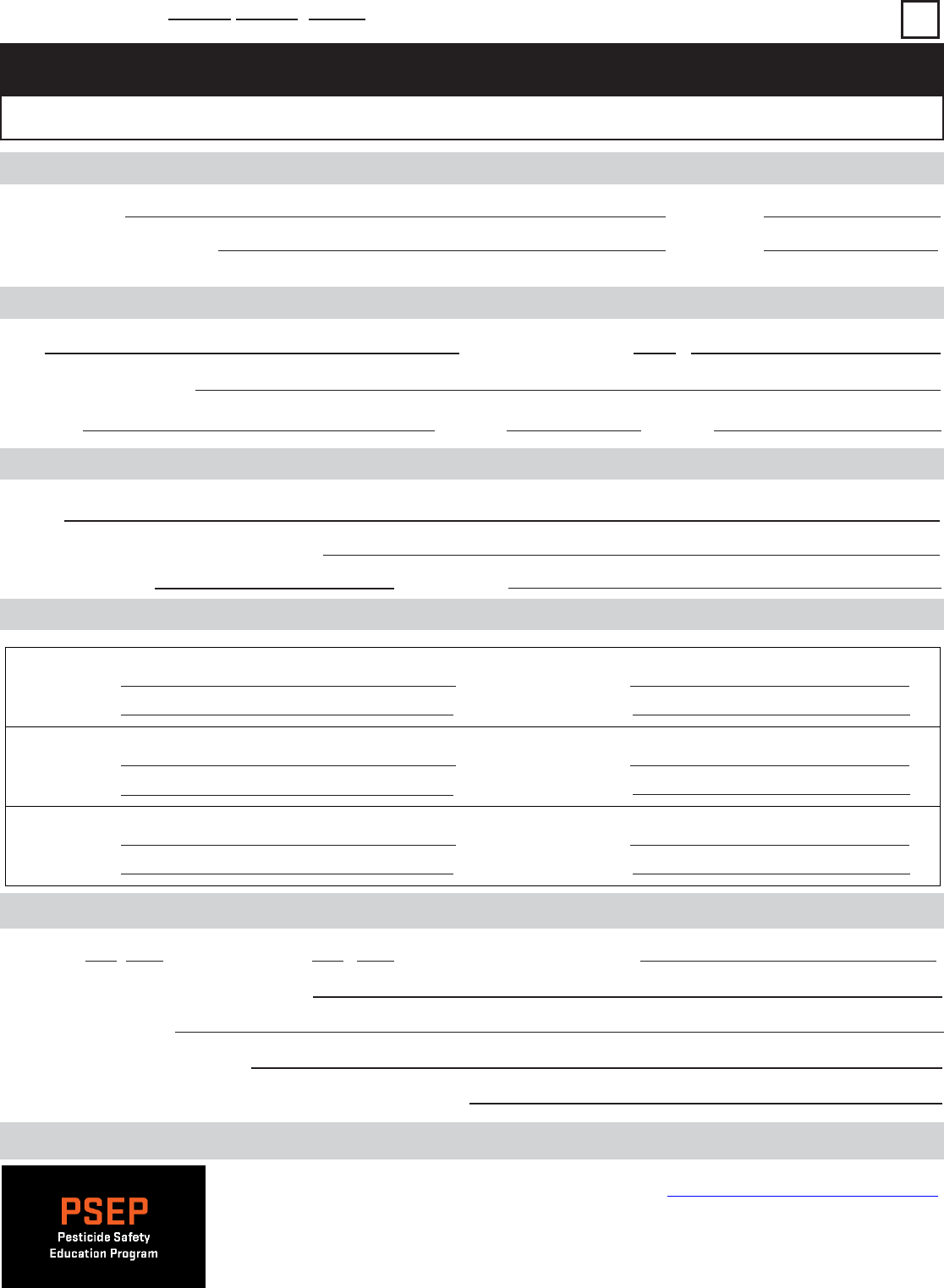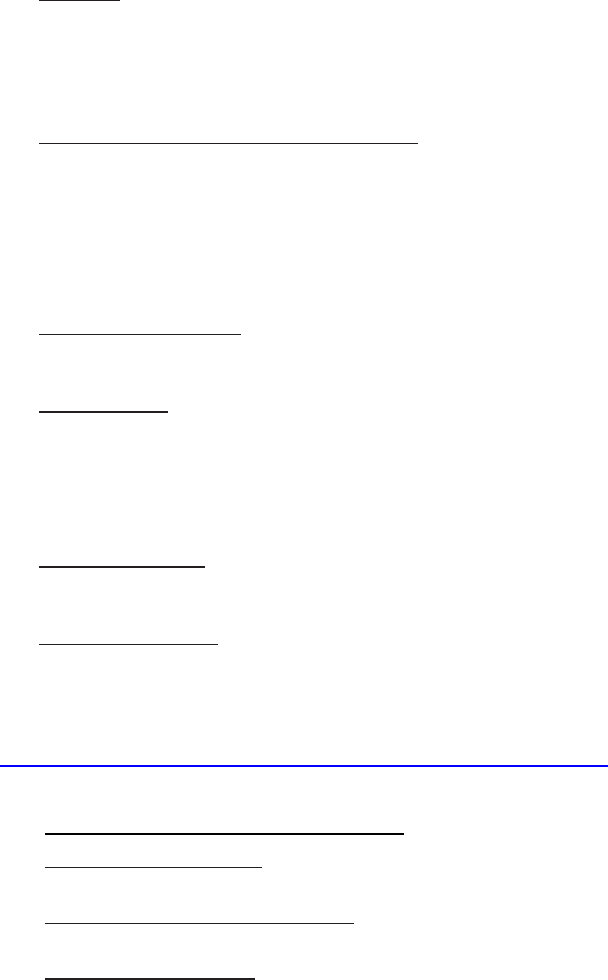
Pesticide Product(s) Used
Comments: Place additional comments (weather, site conditions, pest populations, etc.) on back.
Applicator Name _______________________________________ _________________ License No. __________
Supervising Applicator Name _______________ _____________________ License No. _________________
(if applicable)
Name Business Phone ( )
Address (Route or Street)
City
State
Zip Code
Location
Specific Crop/Commodity/Structure/Other
Size of Area Treated Target Pest(s)
Trade Name
EPA Reg. No.
Pesticide Supplier
Active Ingredient(s)
Trade Name
EPA Reg. No.
Pesticide Supplier
Active Ingredient(s)
Trade Name
EPA Reg. No.
Pesticide Supplier
Active Ingredient(s)
Start Time : AM / PM End Time : AM / PM Equipment Information
Total Amount of Concentrate Product(s)
Total Amount of Carrier
Total Amount of “Other” Material
Restricted Entry Interval (required for agricultural applications)
See PSEP’s website for more recordkeeping templates and information https://agsci.oregonstate.edu/psep/resources
Adapted from University of Wisconsin Extension materials, April 2020
Treated Site
Client
Applicator
Date of Application / /
Restricted-Use Pesticide
Month Day Year
This form meets ALL federal and Oregon pesticide application recordkeeping requirements.
Pesticide Application Record
Application Information

How to Use this Pesticide Application Record Form
Fill out the relevant sections of this form on the day that you apply any pesticide. Keep the form on file for at least 3
years to comply with all current federal and Oregon recordkeeping requirements.
Restricted-Use Pesticide (RUP): Put an ‘X’ in the box in the upper righthand corner of the form if you applied a
restricted- use pesticide. This will make it easier to retrieve records of such applications for the USDA upon request.
Applicator: To save time, fill out the applicator information before you make photocopies of the form. If supervising a
Pesticide Apprentice or Trainee the full name and pesticide license number of the supervising applicator and the
Apprentice and/or trainee is required.
Client: Fill out this part of the form if you are a commercial or public applicator, or if you are applying pesticides as part
of a demonstration or research project.
Treated Site:
Location: The address or a geographic description of the application site (such as circle number, map number or
township/section/range), or GPS coordinates and the size of the area treated (acres, square feet, linear feet, etc.).
Provide enough information that would allow someone to find the way to the location of the application. For example,
if you use a field-numbering system, enter the field number on the form but also have a copy of the farm plan on file
where you keep your pesticide records; that way, a person could look at the farm plan and determine how to get to
the field in question.
Specific Crop/Commodity/Structure /Other: For each pesticide product applied, the specific crop or site of application:
Agricultural applications - the specific crop
"General” and “Structural” applications - the specific area (exterior wall voids, kitchen cabinets, interior
foundation, living room baseboards, etc.)
“Ornamental applications” - the general area (front yard, hedge, fruit tree, etc.)
Other applications – descriptions, similar to the examples above.
Size of Area Treated: Generally speaking, use whatever units of measurement are on the label. Examples
include acres, feet of row, cubic feet, etc. This information is required for agricultural applications but
recommended for all applications.
Target Pest(s): Be as specific as possible; this will help you determine how effective the application was. For
commercial applicators, it is especially important that your client know which pests the treatment was intended to
control.
Pesticide(s) Used: You can get the requested information from the product label. If you tank mix 2 or more pesticide
products, record each product separately. If you use a restricted-use pesticide, even in a tank mix with general-use
pesticides, put an ‘X’ in the box in the upper right-hand corner of the form.
Pesticide Supplier: The full name of the individual or business that supplied the pesticide to you. Do not use initials,
nicknames, or partial names. Required for commercial or public applicator, or if you are applying pesticides as part
of a demonstration or research project.
Active Ingredient(s): This information is required for agricultural applications but recommended for all applications.
Record the common name of the active ingredient that appears in the ingredients statement. If a product contains
more than 1 active ingredient (as is the case with all pre-packaged tank mixes), record the common name of each
active ingredient.
This template is not sufficient for fumigations. Visit Oregon OSHA’s website for information on additional requirements:
https://osha.oregon.gov/Pages/topics/fumigants-and-fumigation.aspx
Application Information: If you apply a tank mix, be sure to record the total amounts for each product in the mix.
Total Amount of Concentrate Product(s): include unit of measure (ounces, pounds, pints, quarts, etc.)
Total Amount of Carrier: include unit of measure (acre, square feet, etc.) or if a specific unit of measure is not
applicable, the total amount applied to site.
Total Amount of “Other” Material: This could include materials such as spreader/ sticker, wetting agent, or drift
retardant.
Equipment Information: Identify the application equipment used (aerosol can, speed sprayer, backpack sprayer,
fogger, etc.) and, if applied aerially, the FAA or “N” number of the aircraft.
Comments: Although not required by law, additional comments can help you evaluate the effectiveness of the pesticide
application. Examples include weather conditions, application equipment, adjuvants, and timing of application (e.g.,
preplant incorporated or postemergence). Because you will use a separate recordkeeping form for each application,
write your optional comments on the blank back of the photocopied form.
